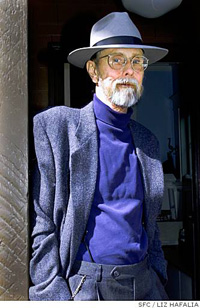Appreciation: Humor was Bruce Conner’s art
by Kenneth Baker, Chronicle Art Critic
San Francisco Chronicle
July 11, 2008
 Having announced his death on two previous occasions, Bruce Conner actually did die on Monday at 74.
Having announced his death on two previous occasions, Bruce Conner actually did die on Monday at 74.
The false alarms were part of his continual toying with the nature of personal and artistic identity. Conner liked to have control – the neatness of his house attested to that – and the nearest he could come to controlling public information about himself was to inject it with ruses and contradictions.
The shaggy look of his early assemblages earned Conner a place in the Bay Area tendency briefly known as Funk art. But that shagginess is deceptive. The unflinching, albeit intuitive, control he brought to those works’ composition accounts for the inventive power that still burns through their period quality when encountered half a century later.
Long before the shaky ground of selfhood became a theme of postmodernism, Conner was working and playing with it. The work in his 2000 retrospective at the de Young Museum was so diverse that, as I wrote at the time, “it could almost be taken for the output of a movement rather than an individual.”
On the eve of that reputation-making show, Conner declared his intent to become again – as he had once been – an anonymous artist. “On the 12-step program of Artists Anonymous,” he said in conversation, “the first is never acknowledging any of your work, after never signing it. … Anyone who has a drawing of mine from before 1960 without a signature has an authentic work.”
Conner’s work is distinguished by a nearly unique combination of visual and emotional impact and artistic disguise.
Watch a piece by him such as the collage film “Take the 5:10 to Dreamland,” something of a landscape piece, and there is no way to decide how he felt about its eerie lyricism. Did he enjoy it? Did he regard it as an inevitable by-product of the materials in hand, or of our culturally conditioned reception? Composing the whole thing from found footage, he set the rationale of his decisions at an unbridgeable remove.
Conner chafed against people’s – including critics’ – habit of assuming a “one to one correspondence” between an artist’s thinking and his work. He preferred to “think of the artist on the model of a writer, a playwright or an actor, someone who works with narrative, irony and changing voices.”
I suspect that Conner still has not achieved the recognition he merits because of critics’ and the public’s inability to break with the model of authorship that he found so constraining. To admiring younger artists, his death represents a loss beyond recompense. “Life on Mars,” the current Carnegie International Exhibition at the Carnegie Museum of Art in Pittsburgh, includes a dozen works by Conner.
(An exhibition of Conner’s photographs of the ’70s punk rock scene is on view at the Berkeley Art Museum through Aug. 3.)
Preparing to interview Conner in 2000, I was told by several people, including him, that his health dictated a brief conversation, necessarily in the morning.
But as our encounter progressed, he seemed to gain vigor, pouring forth one story and quotable remark after another, while I struggled to keep pace with transcription. After three hours, I left, drained physically and emotionally; he seemed fully alert and ready to meet the day.
I felt on that occasion that I had truly met the creative force behind his work. No wonder he could jump from filmmaking to collage to photography to conceptual art to translating his collages into tapestries, seemingly without resistance.
“When I’m asked a question, I tend to answer with a story,” Conner said to me, hence the title of his 2000 retrospective, “2000 B.C.: The Bruce Conner Story, Part II,” which also sounded, not incidentally, like the title of a Hollywood biopic.
The gravity of some of his work’s motifs – mushroom clouds, for example – and an aloof personal style may have kept many people from recognizing in Conner a great comic artist. “My entire history as an artist coincides with the history of the bomb,” he told me in 2000, “and it’s colored almost everything I’ve done. But I also don’t see why you can’t have a good time and be aware of your own mortality.”
Other Links of Interest:
